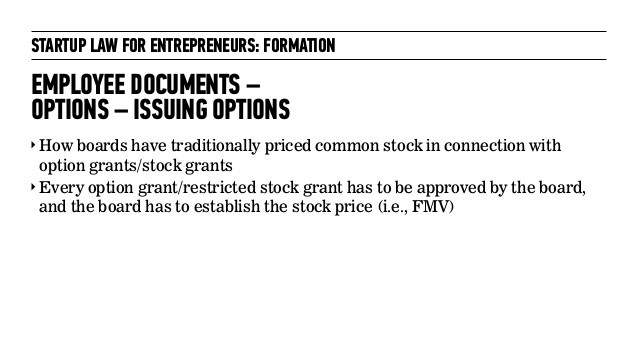Issuing Stock Options 10 Tips for Entrepreneurs
Post on: 1 Август, 2015 No Comment

Issuing Stock Options: Ten Tips For Entrepreneurs
by Scott Edward Walker on November 11th, 2009
Fred Wilson. a New York City-based VC, wrote an interesting post a few days ago entitled “Valuation and Option Pool ,” in which he discusses the “contentious” issue of the inclusion of an option pool in the pre-money valuation of a startup. Based on the comments to such post and a google search of related posts, it occurred to me that there is a lot of misinformation on the Web with respect to stock options – particularly in connection with startups. Accordingly, the purpose of this post is (i) to clarify certain issues with respect to the issuance of stock options; and (ii) to provide ten tips for entrepreneurs who are contemplating issuing stock options in connection with their venture.
1. Issue Options ASAP . Stock options give key employees the opportunity to benefit from the increase in the company’s value by granting them the right to buy shares of common stock at a future point in time at a price (i.e. the “exercise” or “strike” price) generally equal to the fair market value of such shares at the time of the grant. The venture should thus be incorporated and, to the extent applicable, stock options should be issued to key employees as soon as possible. Clearly, as milestones are met by the company subsequent to its incorporation (e.g. the creation of a prototype, the acquisition of customers, revenue, etc.), the value of the company will increase and thus so will the value of the underlying shares of stock of the option. Indeed, like the issuance of shares of common stock to the founders (who rarely receive options), the issuance of stock options to key employees should be done as soon as possible, when the value of the company is as low as possible.
2. Comply with Applicable Federal and State Securities Laws . As discussed in my post on launching a venture (see #6 here ), a company may not offer or sell its securities unless (i) such securities have been registered with the Securities and Exchange Commission and registered/qualified with applicable State commissions; or (ii) there is an applicable exemption from registration. Rule 701, adopted pursuant to Section 3(b) of the Securities Act of 1933, provides an exemption from registration for any offers and sales of securities made pursuant to the terms of compensatory benefit plans or written contracts relating to compensation, provided that it meets certain prescribed conditions. Most states have similar exemptions, including California, which amended the regulations under Section 25102(o) of the California Corporate Securities Law of 1968 (effective as of July 9, 2007) in order to conform with Rule 701. This may sound a bit self-serving, but it is indeed imperative that the entrepreneur seek the advice of experienced counsel prior to the issuance of any securities, including stock options: non-compliance with applicable securities laws could result in serious adverse consequences, including a right of rescission for the securityholders (i.e. the right to get their money back), injunctive relief, fines and penalties, and possible criminal prosecution.
3. Establish Reasonable Vesting Schedules . Entrepreneurs should establish reasonable vesting schedules with respect to the stock options issued to employees in order to incentivize the employees to remain with the company and to help grow the business. The most common schedule vests an equal percentage of options (25%) every year for four years, with a one-year “cliff” (i.e. 25% of the options vesting after 12 months) and then monthly, quarterly or annually vesting thereafter – though monthly may be preferable in order to deter an employee who has decided to leave the company from staying on board for his next tranche. For senior executives, there is also generally a partial acceleration of vesting upon (i) a triggering event (i.e. “single trigger” acceleration) such as a change of control of the company or a termination without cause; or (ii) more commonly, two triggering events (i.e. “double trigger” acceleration) such as a change of control followed by a termination without cause within 12 months thereafter.
4. Make Sure All of the Paperwork Is in Order . Three documents must generally be drafted in connection with the issuance of stock options: (i) a Stock Option Plan, which is the governing document containing the terms and conditions of the options to be granted; (ii) a Stock Option Agreement to be executed by the Company and each optionee, which specifies the individual options granted, the vesting schedule and other employee-specific information (and generally includes the form of Exercise Agreement annexed as an exhibit); and (iii) a Notice of Stock Option Grant to be executed by the Company and each optionee, which is a short summary of the material terms of the grant (though such Notice is not a requirement). In addition, the Board of Directors of the Company (the “Board”) and the stockholders of the Company must approve the adoption of the Stock Option Plan; and the Board or a committee thereof must also approve each individual grant of options, including a determination of the fair market of the underlying stock (as discussed in paragraph 6 below).
5. Allocate Reasonable Percentages to Key Employees . The respective number of stock options (i.e. percentages) that should be allocated to key employees of the company generally depends upon the stage of the company. A post-Series-A-round company would generally allocate stock options in the following range (note: the number in parentheses is the average equity granted at the time of hire based on the results from a 2008 survey published by CompStudy ): (i) CEO – 5% to 10% (avg. of 5.40%); (ii) COO – 2% to 4% (avg. of 2.58%); (iii) CTO – 2% to 4% (avg. of 1.19%); (iv) CFO – 1% to 2% (avg. of 1.01%); (v) Head of Engineering – .5% to 1.5% (avg. of 1.32%); and (vi) Director .4% to 1% (no avg. available). As noted in paragraph 7 below, the entrepreneur should try to keep the option pool as small as possible (while still attracting and retaining the best possible talent) in order to avoid substantial dilution.

6. Make Sure the Exercise Price Is the FMV of the Underlying Stock . Under Section 409A of the Internal Revenue Code, a company must ensure that any stock option granted as compensation has an exercise price equal to (or greater than) the fair market value (the “FMV”) of the underlying stock as of the grant date; otherwise, the grant will be deemed deferred compensation, the recipient will face significant adverse tax consequences and the company will have tax-withholding responsibilities. The company can establish a defensible FMV by (i) obtaining an independent appraisal; or (ii) if the company is an “illiquid start-up corporation,” relying on the valuation of a person with “significant knowledge and experience or training in performing similar valuations” (including a company employee), provided certain other conditions are met.
7. Make the Option Pool As Small As Possible to Avoid Substantial Dilution . As many entrepreneurs have learned (much to their surprise), venture capitalists impose an unusual methodology for calculating the price per share of the company following the determination of its pre-money valuation i.e. the total value of the company is divided by the “fully diluted” number of shares outstanding, which is deemed to include not only the number of shares currently reserved for in an employee option pool (assuming there is one), but also any increase in the size (or the establishment) of the pool required by the investors for future issuances. The investors typically require a pool of approximately 15-20% of the post-money, fully-diluted capitalization of the company. Founders are thus substantially diluted by this methodology, and the only way around it, as discussed in an excellent post by Venture Hacks, is to try to keep the option pool as small as possible (while still attracting and retaining the best possible talent). When negotiating with the investors, entrepreneurs should therefore prepare and present a hiring plan that sizes the pool as small as possible; for example, if the company already has a CEO in place, the option pool could be reasonably reduced to closer to 10% of the post-money capitalization.
8. Incentive Stock Options May Only Be Issued to Employees . There are two types of stock options: (i) non-qualified stock options (“NSOs”) and (ii) incentive stock options (“ISOs”). The key difference between NSOs and ISOs relates to the ways they are taxed: (i) holders of NSOs recognize ordinary income upon the exercise of their options (regardless of whether the underlying stock is immediately sold); and (ii) holders of ISOs do not recognize any taxable income until the underlying stock is sold (though Alternative Minimum Tax liability may be triggered upon the exercise of the options) and are granted capital-gains treatment if the shares acquired upon exercise of the options are held for more than one year after the exercise date and are not sold prior to the two-year anniversary of the options’ grant date (provided certain other prescribed conditions are met). ISOs are less common than NSOs (due to the accounting treatment and other factors) and may only be issued to employees; NSOs may be issued to employees, directors, consultants and advisors.
9. Be Careful When Terminating At-Will Employees Who Hold Options . There are a number of potential claims at-will employees could assert relative to their stock options in the event that they are terminated without cause, including a claim for breach of the implied covenant of good faith and fair dealing. Accordingly, employers must exercise care when terminating employees who hold stock options, particularly if such termination occurs close to a vesting date. Indeed, it would be prudent to include in the employee’s stock option agreement specific language that: (i) such employee is not entitled to any pro rata vesting upon termination for any reason, with or without cause; and (ii) such employee may be terminated at any time prior to a particular vesting date, in which event he will lose all rights to unvested options. Obviously, each termination must be analyzed on a case-by-case basis; however, it is imperative that the termination be made for a legitimate, non-discriminatory reason.
10. Consider Issuing Restricted Stock in Lieu of Options . For early-stage companies, the issuance of restricted stock to key employees may be a good alternative to stock options for three principal reasons: (i) restricted stock is not subject to Section 409A (see paragraph 6 above); (ii) restricted stock is arguably better at motivating employees to think and act like owners (since the employees are actually receiving shares of common stock of the company, albeit subject to vesting) and thus better aligns the interests of the team; and (iii) the employees will be able to obtain capital gains treatment and the holding period begins upon the date of grant, provided the employee files an election under Section 83(b) of the Internal Revenue Code. (As noted in paragraph 8 above, optionholders will only be able obtain capital gains treatment if they were issued ISOs and then meet certain prescribed conditions.) The downside of restricted stock is that upon the filing of an 83(b) election (or upon vesting, if no such election has been filed), the employee is deemed to have income equal to the then fair market value of the stock. Accordingly, if the stock has a high value, the employee may have significant income and perhaps no cash to pay the applicable taxes. Restricted stock issuances are thus not appealing unless the current value of the stock is so low that the immediate tax impact is nominal (e.g. immediately following the company’s incorporation).














